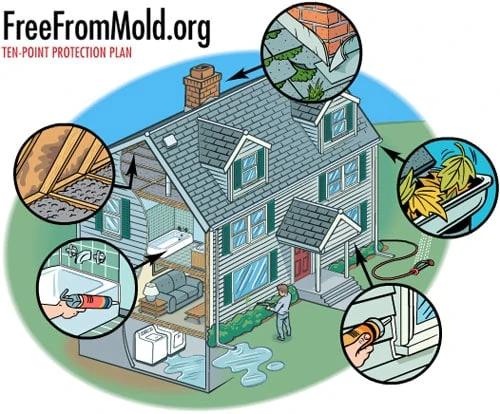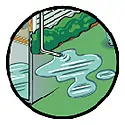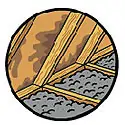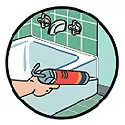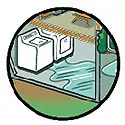Worried about mold in your home? Armed with a checklist, caulk gun and a common-sense plan, homeowners can overcome the hysteria about mold and protect their most valuable asset at the same time.
“Conquering mold is all about venting and sealing. Get rid of the moisture and you’ve banished your mold problem,” says Ed Keith, senior engineer with APA – The Engineered Wood Association. “Our research staff took a hard look at current recommendations from the top building scientists and drew on our own experience with the building industry to come up with simple ways for homeowners to fight back.”
The result is APA’s Ten-Point Protection Plan for detecting and preventing home moisture problems. The plan covers a home’s exterior (roof/chimney, gutters/downspouts, windows/doors/siding), perimeter (drainage, sprinklers, landscaping) and interior (attic, ventilation, kitchen/bath, basement). Following the plan’s routine maintenance suggestions keeps minor mold problems from becoming major headaches.
“We’ve seen folks seal their homes up tight and forget about the importance of venting moisture. The ventilation step reminds people not to let water collect from steamy showers, dishwashers and washing machines. Using a properly vented exhaust fan regularly keeps indoor spaces dry,” says Keith.
Industry research points to poorly sealed windows and doors as major moisture intrusion culprits. The Ten-Point Protection Plan advises using caulking and weatherstripping to seal windows, doors and all locations where utilities penetrate the exterior of the home.
Roofs require special attention. Some roofs can be inspected easily during a walk around the house with a pair of binoculars. Others require closer inspection. According to Keith, one important step is to remove any moss and lichen growth. Roof valleys and intersections should be free of debris. And cracked flashing or worn roofing should be professionally repaired.
Gardeners sometimes unintentionally create moisture problems. “Position sprinklers to water your yard, not your house,” Keith suggests. “And trim your shrubs back to avoid constant contact with the house, or worse yet, penetration of the siding.”
The Big Ten
Protect your home from mold and moisture with these tips.
Roof – Replace missing, upturned, or irregular shingles. Direct water down the roof, never up under the shingles. Look for exposed or protruding nails. Pull the nail and replace with a larger, hot-dip galvanized nail if the flashing is galvanized sheet metal, or stainless steel nail if the flashing is stainless steel. Remove moss and lichen growth anywhere on the roof using a broom or garden hose with a spray nozzle. Remove debris build-up in valleys and at wall-to-roof intersections. Inspect flashing around chimney and penetrations. If flashing has cracked or pulled away, call in an expert to repair.
Gutters/Downspouts – Clean gutters with a blower, hose or broom. Using a hose will help pinpoint leaks and other trouble spots. Use gutter cement on cracks, or replace the gutter sections according to the manufacturer’s instructions. Replace rusted screws and make sure downspouts drain away from the house.
Windows/Doors/Siding – Inspect and recaulk siding, windows, utility penetrations and doors. Place a foam backer rod in seams more than 1/2 inch wide or 1/4 inch deep. Check that the weatherstripping around doors and windows seals tightly to prevent moisture from entering. Inspect stucco and brick surfaces for cracked mortar; patch kits from your hardware store. Keep a minimum 6 inches of clearance between the siding and the ground.
Drainage – Make sure that perimeter ground slopes away from the foundation. If downspouts dead-end near the foundation, add splash blocks to redirect water away from the foundation. Inspect the outdoor deck connection to the house. This is a major source of water intrusion that often goes unnoticed. This connection should be flashed and have sufficient space between the ledger board and the deck boards to allow drainage away from the house.
Sprinklers – Water your plants, not your house. Redirect lawn sprinklers so they do not wet the siding, windows or foundation walls. Overwatering your lawn or plants can create moisture and mold problems even in the summer.
Landscaping – Trim plant life away from the siding. Large shrubs or vegetation may need to be moved if foliage persistently contacts siding, windows or utility penetrations like dryer vents. Tree roots can interfere with perimeter footing drain systems, disrupting the flow of water away from the house and causing dampness or flooding along the foundation and into the basement. Design your landscaping to minimize potential root blockage of underground pipes.
Attic – Look for water stains on the underside of the roof, rusted nails and discolored moldy sections on any surface. If you find any of these moisture warning signs, look for the source of the moisture. This could be a faulty vent that isn’t directing air to the outside. Also check that there is room for air to flow from the eaves (soffit vents) into the attic space and out the upper roof vents.
Ventilation – Install timers on bathroom and laundry fans, and run fans for 20 minutes after showers. Your bath/kitchen/laundry fan ducts should vent outside and never terminate in the attic. Do not vent dryers inside the home. Use an approved aerosol foam sealant to seal around any ceiling penetrations that may allow moist air to flow into the attic space. Place foam rubber insulation gaskets around attic space access panels.
Kitchen/Bath – Inspect plumbing fixtures, paying particular attention to areas under sinks and toilets and around shower and tub enclosures. Look for stains, cracks and mold on caulk and repair as necessary. Use tile and marble sealers annually or as recommended by manufacturers.
Basement – Check your basement and crawlspace for moisture problems: standing water, mold on floor joists or rust on metal fasteners. Replace loose or missing batt insulation. If crawlspace is not insulated, install a 6-millimeter polyethylene vapor barrier over exposed ground. If you find serious moisture damage or standing water in either the crawlspace or basement, call a contractor to repair and correct the source of the problem.
For more in-depth information on what you can do to prevent mold, visit APA’s website at www.FreeFromMold.org


